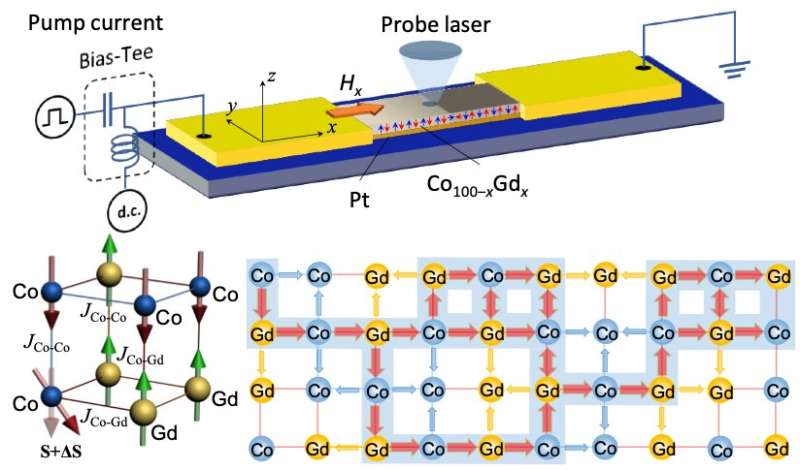(Top) Device diagram. (Lower left) Schematic of antiferromagnetic exchange coupling in a ferrimagnet CoGd alloy and (lower right) the accelerated spin angular momentum transfer via Co–Gd links. Credit: Cai et al.
Spin-orbit torque (SOT) magnetization switching is a phenomenon induced by a spin current, which is in turn generated by a charge current. Eliciting this phenomenon could help to manipulate the magnetization in spintronic devices, potentially increasing their performance.
Despite their potential advantages, so far, most ferromagnetic spin-orbit torque systems have been found to be limited in their operation speed, primarily due to their inherent magnetization dynamics. Some studies suggested that antiferromagnetic and ferrimagnetic materials, which contain groups of atoms with opposing magnetic moments, could help to overcome this limitation, enabling faster spin dynamics.
A research team at National University of Singapore has been conducting research investigating spin-orbit torque switching in compensated ferrimagnets for several years. In a recent study featured in Nature Electronics,they successfully achieved ultrafast SOT magnetization switching in ferrimagnetic cobalt-gadolinium (CoGd) alloy devices.
"We have been working on current-induced magnetization switching in various magnetic materials," Kaiming Cai, one of the researchers who carried out the study, told TechXplore. "Our recent work directly demonstrates the ultrafast operation of magnetization switching in a CoGd ferrimagnetic device, combined with low-energy consumption."
In their previous studies, the researchers identified a series of characteristic physical phenomena occurring in ferrimagnets. For instance, they found that these materials exhibit enhanced SOT efficiencies due to a property known as negative exchange interaction. More recently, Hyunsoo Yang, who led the research team, and some of his colleagues also observed a long spin coherence length and bulk-like torque characteristics in a ferrimagnetic multilayer.
"Our previous works highlighted strong current-induced torques and high switching efficiency in ferrimagnet SOT devices," Yang said. "In our new study, we wanted to unveil the underlying physics of the high SOT efficiency in compensated ferrimagnets. From an application viewpoint, we designed a sub-nanosecond and low-power memory based on ferrimagnets."
Ultrafast and energy-efficient switching is an inherent property of ferrimagnetic materials. The antiferromagnetically coupled Co-Gd links in the material investigated by Yang and his colleagues accelerate the spin angular momentum transfer, which results in faster switching for ferrimagnet SOT devices.
The researchers collected time-resolved measurements using a stroboscopic pump-probe technique. This allowed them to directly observe SOT switching dynamics over time, subsequently comparing them with those observed in ferromagnetic materials.
"In our experiments, we were able to measure the pulse current duration and switching time directly," Yang said. "The ferrimagnetic devices can be switched by a sub-nanosecond current pulse within a sub-nanosecond switching time. In addition, we extracted the domain wall velocity during SOT switching."
By tuning the composition of the ferrimagnet alloy, Yang and his colleagues were able to reduce the switching time in the CoGd ferrimagnetic device to sub-nanoseconds, achieving a domain wall velocity of 5.7 km/s. Remarkably, this is one of the highest current-induced domain wall velocities at room temperature reported in the literature so far.
"Simultaneously reducing the switching time and power in modern memory devices is now of utmost importance," Cai said. "We have demonstrated a switching time of sub-nanosecond and energy consumption that is one to two orders of magnitude lower than that of conventional ferromagnetic SOT systems."
The findings could have several implications, both for future research and for the development of new devices. In fact, in addition to providing new insight about SOT switching in ferrimagnetic materials, their work introduces a new ultrafast, energy-efficient and highly promising device.
In the future, the device presented in their study could be used to devise non-volatile memories, which could potentially replace cache memories used in many current CPUs, ultimately paving the way for effective in-memory computing applications. Considering that similar ferrimagnetic materials were commercialized for magneto-optical disks in 1998 and applied on a gigabyte scale in the early 2000s, the device could prove to be a viable commercial route for memory technologies.
While initial tests ran by Yang and their colleagues demonstrate the potential of their device, several issues still need to be addressed before it can be implemented on a large scale. For instance, enabling deterministic switching in the device currently requires an external magnetic field, which greatly limits its use in SOT- magnetoresistive random access memory (MRAM) applications.
"Removing the necessity of the external magnetic field will be one of the key directions for our future research work," Yang said. "This can be achieved by engineering materials and device structures. Meanwhile, we will work on pursuing faster and more energy-efficient switching, which could help us to realize SOT switching with the timescale down to tens of picoseconds or even several picoseconds regime."
More information: Kaiming Cai et al. Ultrafast and energy-efficient spin–orbit torque switching in compensated ferrimagnets, Nature Electronics (2020). DOI: 10.1038/s41928-019-0345-8
Rahul Mishra et al. Anomalous Current-Induced Spin Torques in Ferrimagnets near Compensation, Physical Review Letters (2017). DOI: 10.1103/PhysRevLett.118.167201
Jiawei Yu et al. Long spin coherence length and bulk-like spin–orbit torque in ferrimagnetic multilayers, Nature Materials (2018). DOI: 10.1038/s41563-018-0236-9
Journal information: Nature Materials , Physical Review Letters , Nature Electronics
© 2020 Science X Network
























